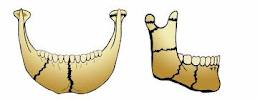We have discussed the principles of management of fractures in Fracture of the Lower Jaw-Part I. In this article we will be discussing a little in depth regarding the management of Lower jaw fractures, or mandibular fractures.
 PRINCIPLES OF MANAGEMENT OF FRACTURES:
PRINCIPLES OF MANAGEMENT OF FRACTURES:
- Reduction of the fracture-Reduction can be done in 2 days: Open Reduction or Closed Reduction, as will be discussed below
- Fixation & stabilization of the fracture-Direct or Indirect
- Immobilization of segments at fracture site
- Occlusion restored-to allow the patient to bite in his original position
- Infection eradicated/prevented-infection can prevent or delay healing, thus it is of essence that infection be avoided. Continue reading